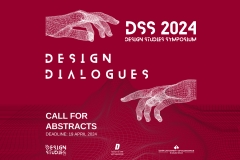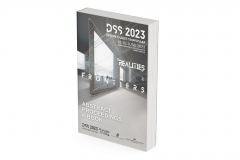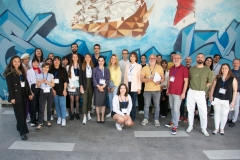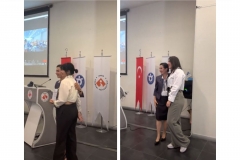
GRADUATE SCHOOL
Design Studies (With Thesis)
FFD 555 | Course Introduction and Application Information
| Course Name |
Imaginary and Futuristic Design Studies
|
|
Code
|
Semester
|
Theory
(hour/week) |
Application/Lab
(hour/week) |
Local Credits
|
ECTS
|
|
FFD 555
|
Fall/Spring
|
3
|
0
|
3
|
7.5
|
| Prerequisites |
None
|
|||||
| Course Language |
English
|
|||||
| Course Type |
Elective
|
|||||
| Course Level |
Second Cycle
|
|||||
| Mode of Delivery | - | |||||
| Teaching Methods and Techniques of the Course | - | |||||
| Course Coordinator | - | |||||
| Course Lecturer(s) | ||||||
| Assistant(s) | - | |||||
| Course Objectives | The objective of the course is to equip the students with the skills of relating and evaluating the previous theoretical and practical knowledge and experience with a different and innovative way within the concept of future. Within the scope of the course, rather than being traditional, it is aimed to generate unique ideas by examining, inquiring and analysing the possible and assumptive approaches for future. In this context, it is aimed to handle theoretical and practical studies on the understanding and designing of visionary life opportunities and environments. Nonetheless, the development of original design ideologies and presentation attributes are also among the aims and expectations of the course. |
| Learning Outcomes |
The students who succeeded in this course;
|
| Course Description | In this course the students will introduce original design ideas and ideologies on futuristic life possibilities and environments by conducting reading, criticism and discussions on art, philosophy, science and conceptual design theories and practice. |
|
|
Core Courses | |
| Major Area Courses | ||
| Supportive Courses |
X
|
|
| Media and Management Skills Courses | ||
| Transferable Skill Courses |
WEEKLY SUBJECTS AND RELATED PREPARATION STUDIES
| Week | Subjects | Related Preparation |
| 1 | INTRODUCTION, GUEST LECTURER - - - Lecture by Prof. Dr. Yüksel Demir, İstanbul Technical University | |
| 2 | THEORETICAL BACKGROUND - - - Introduction and discussion to the course, Presentation on Mars competition, Utopia/Heterotopia/Dystopia/E-topia - - - Annotated Review: Define Utopia/Heterotopia/Dystopia and explain your perspective for Mars Project | H. Silverman (1980). From Utopia/dystopia to Heterotopia: An interpretative Topology. Philosophy & Social Criticism. M. Foucault (1967). Architecture /Mouvement/ Continuité October, 1984; (“Des Espace Autres,” March 1967 Translated from the French by Jay Miskowiec) of Other Spaces: Utopias and Heterotopias. Mars 2050: https://www.arkitera.com/yarisma/mars-2050-yasam-alani-fikir-yarismasi Marstopia:https://www.e-architect.co.uk/competitions/marstopia-architecture-and-design-competition Moontopia:https://www.dezeen.com/2017/01/17/nine-visions-lunar-architecture-moon-moontopia-competition/ Why not? http://www.science20.com/robert_inventor/blog/ten_reasons_not_to_live_on_mars_great_place_to_explore-118531 |
| 3 | GUEST LECTURER - - - Lecture by Prof. Asterios Agkathis, University of Liverpool | |
| 4 | BIOMIMICRY - - - Design in Extreme Environments using Biomimicry - - - Define the terms, Biomimicry / Biomimetic/ Biomaterial. | G.Varinlioglu, B.Pasin, H.D.Clarke (2018) Unconventional Formulations in Architectural Curricula: An Atelier on Design for Outer Space Architecture. AZ ITU Journal Of The Faculty Of Architecture, ISBN: 2564-7474 Michael Pawlyn: https://www.ted.com/talks/michael_pawlyn_using_nature_s_genius_in_architecture/up-next Pawlyn, M. (2019). Biomimicry in architecture. Routledge. Smart Inventions Inspired by Nature: https://www.bloomberg.com/news/photo-essays/2015-02-23/14-smart-inventions-inspired-by-nature-biomimicry |
| 5 | Corona Break | |
| 6 | EXTREME ENVIRONMENT DESIGN - - - Space Research, space travel and living in outer space - - - Annotated Review: Define cabin ecology and outer space design. | Leach, N. (Ed.). (2014). Space architecture: The new frontier for design research. John Wiley & Sons. M. Wilsing and N.A. Wilsing (2004) Integrating ‘Outer Space Design’ into Design Curriculum. International Journal Of Art And Design Education , Vol. 23, No. 1, 73-80, ISBN: 1476-8062 |
| 7 | SCIENCE FICTION - - - Cyberspace/e-topia/Neuromancer - - - Annotated Review: Define cyberspace and give a current example of a sci-fi movie. | Neuromancer (trailer): https://www.youtube.com/watch?v=b1kJI-UvYwQ Blog on Neuromancer: http://www.digilogue.com/pop-kulturu-ve-teknolojinin-kusursuz-sentezi-neuromancer/ M. Heim (1992) The Erotic ontology of Cyberspace in Cyberspace First Steps by Michael Benedikt. Blade Runner (1982) https://www.youtube.com/watch?v=eogpIG53Cis Blade Runner (2019) http://bladerunnermovie.com/ Dune (1984) by David Lynch, https://www.imdb.com/title/tt0087182/ |
| 8 | Presentations by students/ Prejury | |
| 9 | CRITICAL DESIGN AND DESIGN THINKING - - -Critical Design and Design Thinking and Presentation of the Term Project | McDougall, W. A. (1982). Technocracy and Statecraft in the Space Age--Toward the History of a Saltation. The American Historical Review, 87(4), 1010-1040. Bardzell, J., & Bardzell, S. (2013, April). What is" critical" about critical design?. In Proceedings of the SIGCHI conference on human factors in computing systems (pp. 3297-3306). Hales, D. (2013). Design fictions an introduction and provisional taxonomy. Digital Creativity, 24(1), 1-10. |
| 10 | Holidays | |
| 11 | IMMERSIVE ENVIRONMENTS AND DIGITAL MANUFACTURING - - - Immersive Environments (AR/VR/XR), Digital Fabrication | Portman, M. E., Natapov, A., & Fisher-Gewirtzman, D. (2015). To go where no man has gone before: Virtual reality in architecture, landscape architecture and environmental planning. Computers, Environment and Urban Systems, 54, 376-384. Krevelan and Poelman (2010). A Survey of Augmented Reality Technologies, Applications and Limitations, The International Journal of Virtual Reality. B. Kolarevic (2003), Architecture in the Digital Age, Design and Manufacturing. |
| 12 | ARTIFICIAL INTELLIGENCE - - - Lecture by Lale Başarır on AI, Machine learning, image recognition | Silva N.F., Bridges A.H. (1997) Human-Computer Interaction and Neural Networks in Architectural Design. In: Junge R. (eds) CAAD futures 1997. Springer, Dordrecht Isola, P., Zhu J.Y., Zhou, T. and Efros, A.A., (2016). Image-to-Image Translation with Conditional Adversarial Networks, Arxiv Huang, Weixin, and Hao Zheng. (2018). "Architectural Drawings Recognition and Generation through Machine Learning." The 38th Annual Conference of the Association for Computer Aided Design in Architecture. Mexico City: ACADIA2018. 156-165. |
| 13 | Presentations and discussion of term paper | |
| 14 | Presentations and discussion of term paper | |
| 15 | FINALS - - - Presentations and discussion of term paper - - - Submission of the Mars 2050 Project | |
| 16 | FINALS - - - Overall Evaluation / Term Paper Submission |
| Course Notes/Textbooks | |
| Suggested Readings/Materials | Chosen academic articles and book chapters |
EVALUATION SYSTEM
| Semester Activities | Number | Weigthing |
| Participation |
16
|
10
|
| Laboratory / Application | ||
| Field Work | ||
| Quizzes / Studio Critiques | ||
| Portfolio | ||
| Homework / Assignments |
4
|
20
|
| Presentation / Jury |
1
|
20
|
| Project |
2
|
50
|
| Seminar / Workshop | ||
| Oral Exams | ||
| Midterm | ||
| Final Exam | ||
| Total |
| Weighting of Semester Activities on the Final Grade | ||
| Weighting of End-of-Semester Activities on the Final Grade | ||
| Total |
ECTS / WORKLOAD TABLE
| Semester Activities | Number | Duration (Hours) | Workload |
|---|---|---|---|
| Theoretical Course Hours (Including exam week: 16 x total hours) |
16
|
3
|
48
|
| Laboratory / Application Hours (Including exam week: '.16.' x total hours) |
16
|
0
|
|
| Study Hours Out of Class |
16
|
5
|
80
|
| Field Work |
0
|
||
| Quizzes / Studio Critiques |
0
|
||
| Portfolio |
0
|
||
| Homework / Assignments |
4
|
10
|
40
|
| Presentation / Jury |
1
|
7
|
7
|
| Project |
2
|
25
|
50
|
| Seminar / Workshop |
0
|
||
| Oral Exam |
0
|
||
| Midterms |
0
|
||
| Final Exam |
20
|
0
|
|
| Total |
225
|
COURSE LEARNING OUTCOMES AND PROGRAM QUALIFICATIONS RELATIONSHIP
|
#
|
Program Competencies/Outcomes |
* Contribution Level
|
||||
|
1
|
2
|
3
|
4
|
5
|
||
| 1 | to be able to expand the practical knowledge gained in undergraduate programs with theoretical field of design research, |
X | ||||
| 2 | to be able to examine, interpret data and assess concepts and ideas with research methods of design theory and social sciences, |
X | ||||
| 3 | to be able to identify problems of design disciplines in times of global / environmental crisis and to be able to develop possible solutions for design practitioners, |
X | ||||
| 4 | to be able to expand knowledge on the history of material culture as it relates to design practices of the past, |
X | ||||
| 5 | to be able to promote research on local practices of everyday life and assess the outcome to implement design solutions, |
X | ||||
| 6 | to be able to facilitate interactions in between varied design disciplines and to promote collaborative work to solve complex problems, |
X | ||||
| 7 | to be able to process outcome of design research to be applied in design education, |
X | ||||
| 8 | to be able to instigate research on the new tools, technologies and materials of production in order to accelerate changes in design practices, |
X | ||||
| 9 | to be able to develop an ethical approach towards design professions in order to install social and environmental responsibilities, |
X | ||||
| 10 | to be able to use a foreign language for both chasing the scientific publication and developing proper communication with colleagues from other countries, in written and verbal ways. |
|||||
| 11 | to be able to use computer programs needed in the field design as well as information and communication technologies in advanced levels (“European Computer Driving Licence”, Advanced Level”). |
X | ||||
*1 Lowest, 2 Low, 3 Average, 4 High, 5 Highest
NEWS |ALL NEWS

DSS 2024 CALL FOR PAPERS | THEME: DESIGN DIALOGUES
DSS 2024 CALL FOR PAPERS THEME: DESIGN DIALOGUES The Design Studies Graduate Program and the Faculty of Fine Arts and Design at the Izmir

Abstract Proceedings e-Book for the Design Studies Symposium 2023 is available now!
The Design Studies Symposium 2023 (DSS 2023), organized in collaboration with İzmir University of Economics Graduate School Design Studies Master's and PhD

Design Studies Symposium 2023: Realities & Frontiers
The Design Studies Symposium 2023 (DSS 2023) organized by the IEU Graduate School Design Studies programs was held on 1-2 June, at

The Best Paper Award at the Design Studies Symposium 2023: Realities & Frontiers
The voting for the best presentation award at the Design Studies Symposium 2023 (DSS 2023) organized by the IEU Graduate School Design




